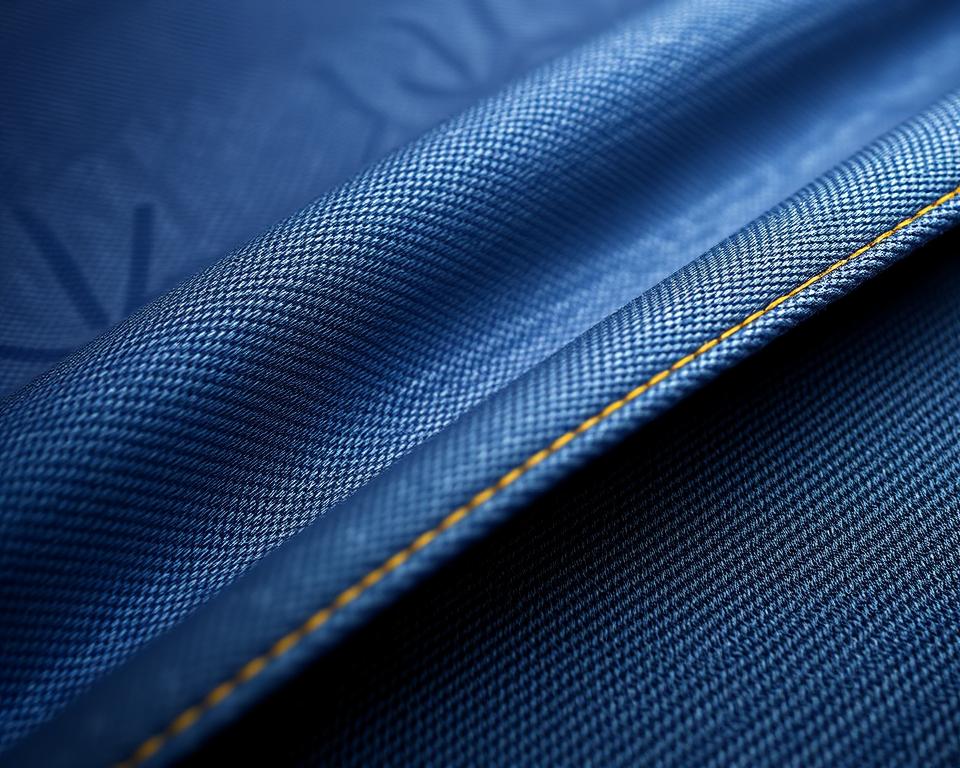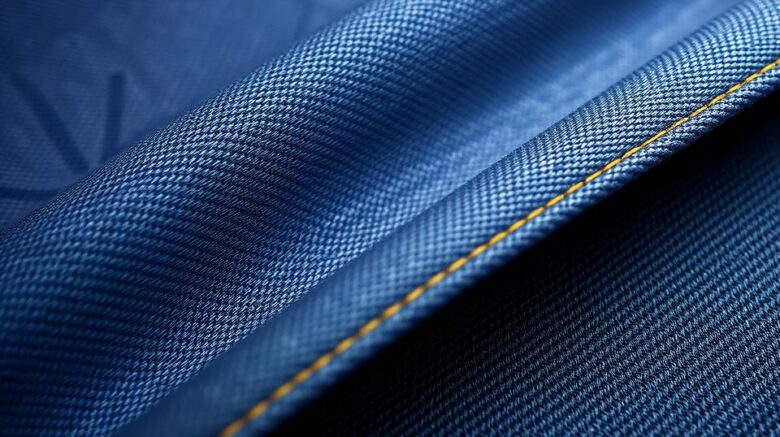A Comprehensive Handbook for Superior denim Selvedge Material
Have you ever pondered why some trousers seem as though they are made to last a lifetime? Everything revolves around the materials and artistry. Take, for instance, the growing movement of premium selvedge. It’s not merely ordinary fabric—it’s a testament to excellence and tradition.
Today, more people are choosing these classic materials for their durability and classic selvedge denim by the yard charm. Be it that you are a DIY sewist or a denim lover, there’s a unique quality about employing high-quality natural fiber and yarn. It goes beyond merely creating trousers; it’s about producing a legacy.
Here at Core Fabrics, we’ve selected a selection of 14.25oz organic cotton and stretch options. These fabrics are tailor-made for everything from raw jeans to high-fashion jacket designs. Eager to discover the realm of top-tier fabrics? Let’s dive in.
Defining Denim Selvedge Fabric?
Why do certain trousers distinguish themselves with their distinctive, self-finished edges? The key is found in the selvedge denim, a high-quality fabric known for its durability and old-school appeal. Differing from standard textiles, this fabric is crafted using traditional methods that have endured through ages.
Understanding Selvedge Denim
Selvedge denim is produced using retro shuttle looms, which produce slender widths of about 30-35 inches. They intertwine the material in a method that delivers self-finished edges, often accented with a signature red line. This process ensures the material is tightly woven and exceptionally sturdy.
Contemporary looms, on the other hand, produce expansive material but do not offer the same level of artistry. Subtle irregularities in selvedge, like twists in the leg or uneven textures, are celebrated as part of its charm. This ideology, often referred to as “wabi-sabi”, honors the appeal of organic flaws.
How Selvedge Denim Is Made
The creation of selvedge denim requires a detailed process. Traditional shuttle looms weave the weft thread alternately, resulting in a compact and resilient textile. This method contrasts with contemporary machines, which focus on quick production and efficiency over quality.
Brands like Karson Denim preserve time-honored Japanese weaving techniques from the 1990s. They purposefully add anomalies to preserve the true character of the material. Every item is graded on a 4-point system, ensuring it fulfills the peak requirements of superiority.
| Feature | Selvedge Denim | Contemporary Denim |
|---|---|---|
| Measure | 30-35 inches | 60+ inches |
| Construction Technique | Shuttle Loom | New-Age Loom |
| Surface | Irregular, Flawed | Consistent |
| Strength | Exceptional | Average |
“The charm of selvedge is found in its flaws—each irregularity speaks of skill and legacy.”
The Legacy of Selvedge Denim
From humble beginnings to global acclaim, the narrative of these textiles is vibrant and motivational. Originally developed as durable workwear in 17th-century France evolved into a mark of classic elegance and artistry.
Origins in Traditional Weaving
The roots of this fabric reaches back to Nîmes, France, where it was referred to as “serge de Nîmes.” First intended for laborers, it was crafted out of robust cotton and yarn. Its resilience rendered it beloved among workers during the Gold Rush.
In the 20th century, it had transformed into a cornerstone for jeans. The shuttering of the Cone Mills White Oak plant marked a turning point. This shift paved the way for Japanese artisans to restore classic fabric-making practices.

Evolution in Modern Denim Production
Post-WWII, Japan embraced vintage American culture. Skilled workers restored classic looms to manufacture authentic reproductions. This devotion to craftsmanship secured the survival of selvedge as a unique product.
Today, advancements from Italy and Turkey have brought forth sustainable mixtures and elastic variants. These improvements have expanded the attraction of this timeless material. At Core Fabrics, we procure internationally, from Montréal to Asia, to deliver to you the top-notch excellence.
“Selvedge’s story is a testament to the perennial merit of quality and tradition.”
The Benefits of Selvedge Denim?
Why does selvedge denim shine in the realm of superior fabrics? Its unique qualities and unmatched durability have made it beloved among aficionados and creatives alike. Whether you’re crafting pants or a structured jacket, this textile delivers a mix of tradition and modern appeal.
Unique Qualities of Selvedge Fabric
Selvedge denim is known for its firm interlacing, which improves tear resistance and fade potential. Unlike standard materials, selvedge denim material is produced using time-honored shuttle looms, yielding a more compact and exceptionally sturdy fabric. Such a process guarantees that all products boast a distinct surface and individuality.
Notable attributes are:
- Hairy, rigid raw denim offers a contrast to pre-washed comfort stretches.
- Through sanforization, sizes become reliable, while untreated fabrics provide a unique shrinkage journey.
- Weight options range from 9.5oz Eco Finish to 14.25oz Organic, catering to diverse applications.
Robustness and Endurance
One of the key attributes of selvedge denim is its long life. The dense fabric structure not only increases durability but also allows for distinctive color fades over time. This renders it a treasured choice for those looking for timeless pieces.
Important aspects:
- Fabrics weighing between 12oz and 14oz are perfect for form-fitting jackets and jeans that mellow with time.
- For classic jean longevity, the 14.25oz True Indigo is a top recommendation.
- Sustainable variants such as recycled cotton combined with indigo blends enhance eco-friendliness.
Core Fabrics offers an assortment of products tailored for every requirement. Whether untreated or sanforized, every item is made to provide outstanding quality and performance.
Selvedge Denim vs. Wide Denim
In the creation of robust and fashionable apparel, the choice of textile plays a crucial role. Two common choices include selvedge and wide denim, both offering different features. Understanding their differences can help you choose the right one for your project.
Contrasting Weave Techniques
Selvedge denim is crafted with traditional shuttle looms, producing narrow widths of 30-35 inches. This selvedge denim jacket process forms firm borders, often marked by a distinctive red line. Conversely, wide denim employs advanced projectile looms, yielding widths of 60 inches or more.
Old-style shuttle looms yield roughly 3m per minute, while modern projectile looms reach speeds of 30 meters per minute. Such speed differences influence both the cost and the texture of the outcome.
Pros and Cons of Each Type
Selvedge denim is renowned for its high-end construction and robustness. Its narrow width makes it ideal for creations where visible hems or patches are desired. However, it can be costlier, generally priced at $23 per meter.
Wide denim is more cost-effective, ranging at $8 per half-meter. Its broader span minimizes excess, well-suited to large projects like furniture covering. However, it lacks the unique edge finish of selvedge.
| Feature | Selvedge Denim | Wide Denim |
|---|---|---|
| Measurement | 30-35 inches | 60+ inches |
| Weaving Process | Traditional Shuttle | Contemporary Projectile Loom |
| Production Speed | 3m per minute | 30m per minute |
| Expense | $23/meter | $8/half-meter |
When precise, structured edges are required—as in Grainline Thayer jackets—selvedge wins out. For larger projects, wide denim offers better value and efficiency. Evaluate your project specifications to choose wisely.
Working with Selvedge Denim
Working with premium materials can elevate your sewing projects to the next level. Be it making trousers, outerwear, or skirts, grasping fabric quantities, proper sewing methods, and maintenance guarantees a polished result. We will examine the optimal use of this classic material.
Material Requirements for Jeans and Jackets
When planning your project, calculating the right amount of material is crucial. Approximately 3-3.3 yards is necessary for men’s jeans, considering defects and shrinkage. For trucker jackets, expect to use around 3.3 yards, while skirts can be made with just 2 yards.
Smart pattern positioning minimizes the impact of defects. Instead of cutting around defects, consider integrating them into your design for a unique look.
| Item | Yardage Needed |
|---|---|
| Men’s Jeans | 3-3.3 yards |
| Trucker-Style Jacket | 3.3 yards |
| Dress | 2 yards |
Sewing Techniques and Maintenance
Employing proper equipment and methods leads to an impeccable finish. Choose #70 to 110 pins and foot accessories made for robust textiles. Gütermann rPET thread works well for contrasting stitches.
Additional advice includes:
- Use a tailor’s clapper for sharp creases without shine.
- Core Fabrics provides denim kits with topstitch thread, rivets, and 9mm buttons for that expert touch.
- For structured edges, like those in jackets, selvedge is the preferred choice.
Proper care extends the life of your creations. Wash sparingly and air dry to maintain the material’s integrity. Adhering to these practices will sustain your creations for years.
The Final Word
Working with high-end textiles is not solely about longevity; it’s about infusing character. Selvedge denim exemplifies this principle, fusing artisanal charm with long-lasting quality. Be it crafting jeans or tailoring a refined jacket, each stitch narrates a tale.
At Core Fabrics, we make it easy to explore your creativity. Our swatch service lets you touch and test the fabric before deciding. Plus, enjoy free shipping on orders over $150 USD across North America.
Eco-friendly mixtures and classic washes are paving the way for the next generation of cotton fabrics. They open fresh avenues for merging sustainability with chic style.
Ready to dive into the world of premium materials? Start shopping today to experience purposeful design. Your subsequent creation may well become an enduring classic.
